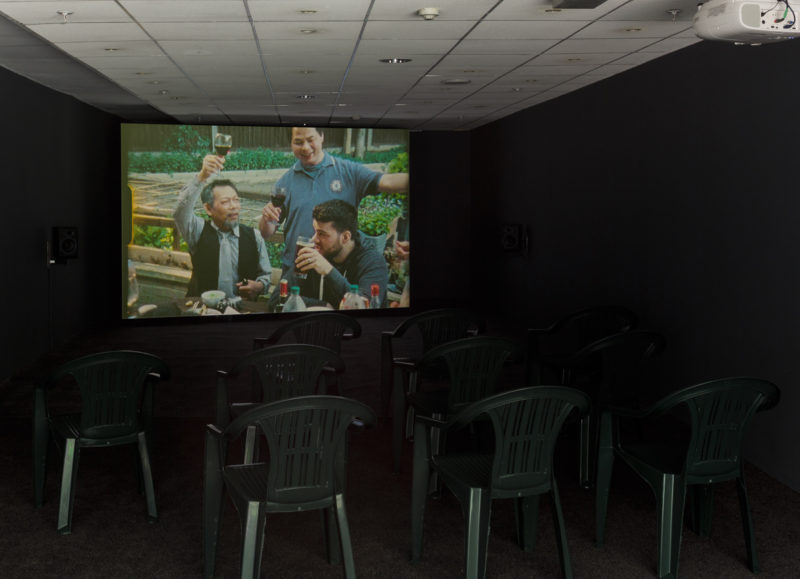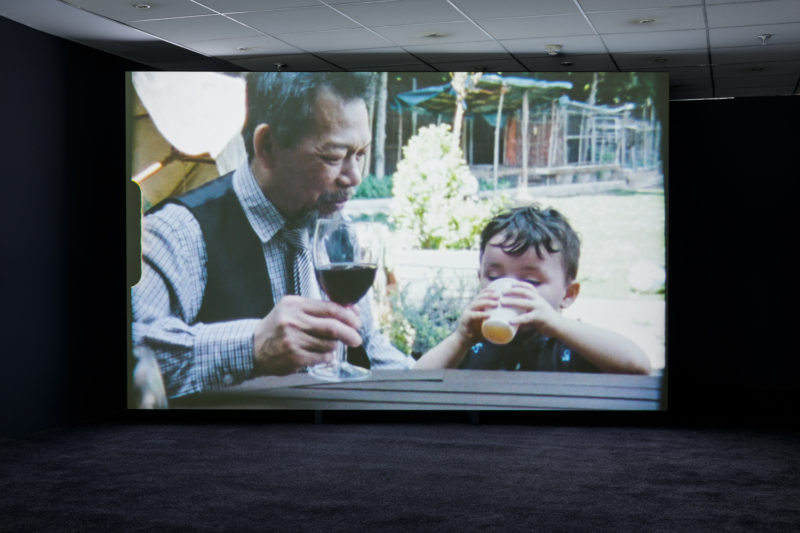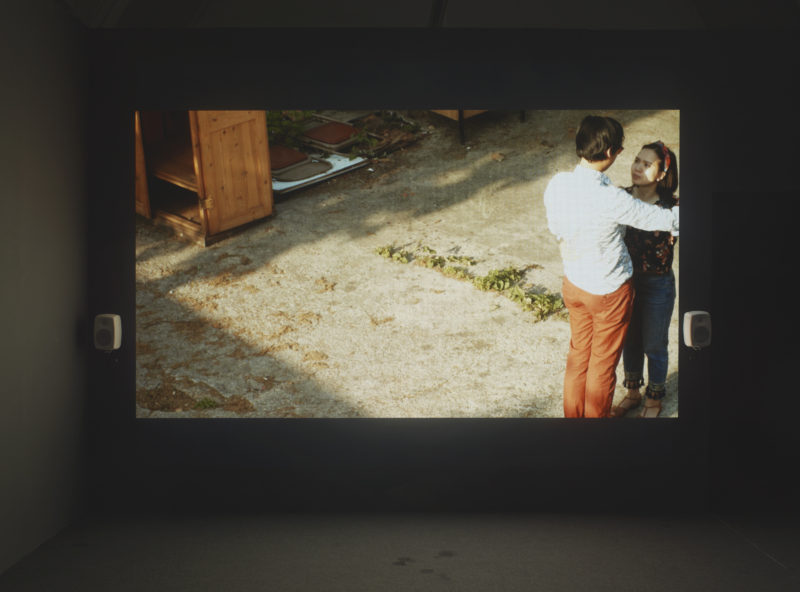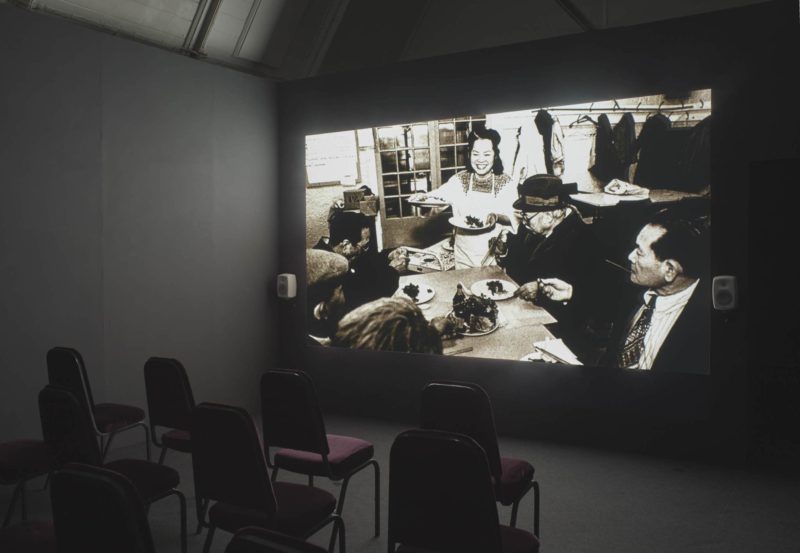
Family, time, and the present are three key pillars of Will Pham’s first solo exhibition Little Vietnam, the most recent show at Turf Projects in London’s Borough of Croydon that took place from May 14 – July 6, 2019. The 16-minute video work of the same name, captured on Super 8 film, depicts several everyday scenes centred around Pham’s multi-generational family: going to church, spending time at the park, preparing for a backyard barbecue at his uncle’s new house, ending at Pham’s parent’s restaurant, Little Vietnam in South Wimbledon. The video is without dialogue; the viewer sneaks glimpses into this life, accompanied by a wistful original score by composer An Tôn Thất. Situated alongside the video work in the space sat a long table covered by a plastic tablecloth, lime green with white letters promoting LittleVietnamSW19.co.uk. It was at this table where Pham served food from the restaurant at the opening reception; a customary gesture of generosity at his last two openings. On a regular day, the table displayed several publications including Guus van der Veer’s Counselling and Therapy for Refugees; Vietnamese refugees since 1982, a research study conducted by the Home Office; Mental health: a Vietnamese perspective, a report by the Vietnamese Mental Health Services; and Carina Hoang’s Boat People; among others.
As I sit in front of my laptop, three weeks after our conversation, I decide to follow in line with the work, piecing together fragments of this sunny Saturday afternoon when I met with Pham at Turf Projects and discussed the process of creating this show, his artistic practice, Vietnamese migration to the UK, and both our struggles for calmness.
Tan: I’ve seen the last two shows that you’ve done this year, and something I find significant about the works you’ve made is that you really make a point to not define the Vietnamese British experience through narratives of trauma and war. At the opening [of Little Vietnam] you said you wanted to portray this life that was quite normal. You have these reading materials accompanying the show to give people a precursor, rather than showing images of trauma in the film. Can you talk a little bit more about that?
Pham: When I made this film what structured it was archival material that I found on YouTube of people escaping by boat–Ken Burns footage that I just ripped–and the French bombing in Vietnam, and basically just context: black and white images shot on film, handheld, very shaky and really violent. In the beginning it was a useful device to have contrast of violence and innocence. I keep doing this thing where I just place two things together and hope for the best, to see what happens. Long story short, I showed it to a friend and she told me to take it out. I didn’t question why or ask her, I just trusted her because she said she definitely would [take it out]. I came to some conclusions: [I could] risk this statement on what Vietnam is about and having some sort of nostalgia or pain from losing the Vietnam War, but it just might not be needed formally, so she told me to just take it out because it might be the case where I’m relying too much on giving the viewer some sort of sadistic pleasure from looking at violence and then having a happy ending.
So I decided to take it out and use the soundtrack that a friend–a French Vietnamese composer who writes music for cinema–decided to give and it’s quite melancholic and there are these voices that I thought would work because of the spiritual overtones. A lot of the scenes in here are in church and have Catholicism, but also there are these violins and cellos. The music structures themes and tone. I don’t need the trauma.
In the An Viet film, the BBC used archival material of boat people escaping, and when I made that film I wanted to make films which were not from an outsider, and I think an outsider would blow up, sensationalize, suffering. Whereas with this one, if my parents were to watch it, or my cousins, I think it would be a bit too close to home. It’s basically a bit more complicated than what the first cut was. The first cut had this scene with the Communist military tanks breaking into Saigon and people escaping by boat and it was really dramatic. It would possibly take away what I want the film to be about, which is talking about time, family.
You said at the opening you didn’t want to produce another work that othered Vietnamese refugees. It’s important to never forget, but why should people who have experienced trauma have it constantly—
—define them.
—exactly, and constantly be trapped in that trauma. In the last few works that you’ve made, that aspect [of trauma] is unspoken, and your work has become more about the resilience of people when they leave and have to start all over again. And the fight for that normalcy, the fight to buy a house, or to establish a community. There’s aesthetically a great delicacy to the work in its portrayal of that resilience. It’s calm and quiet, but it doesn’t feel easy. I don’t feel there is a resolution to any of the works you make.
That calmness is what I always aspire to, the values I want to live by, but that isn’t the case. The situations in the films all have that front. I do think small gestures are very silent, but very strong, and they’re not sexy. Community centres aren’t sexy; the idea of a run down [centre], Vietnamese or ethnic-specific people sitting around playing mah-jong, and it’s really cold and full of old people. It’s not cool. And the restaurant is opposite of these hipster ones; it’s really difficult to work in. There’s constantly shouting and arguing with your family, which is intense, as it’s a family run restaurant.
Explorations of time and family are repeated throughout Pham’s recent work. His film prior to Little Vietnam, titled An Viet* (Well Settled) from 2018, showcases the life and work of Mr. Vu Khanh Thanh, founder of An Viet Foundation, a community centre in Hackney that provides services to the Vietnamese community. A BBC newscast reporting on the migration of Vietnamese boat people to Hackney is layered with history of the centre’s origins as a highly-rated Vietnamese restaurant, convivial conversation with staff in the resource library, and concludes with a final ode to Mr. Vu, with his son sitting in the now-empty building reading aloud from Mr. Vu’s published autobiography that outlines his journey from the North of Vietnam to the UK. In Pham’s practice in the last year, after graduating from the Royal Academy School’s Postgraduate Programme, his artistic practice and family life have blended together. Little Vietnam–the restaurant–was planned to be a big part of the work quite early on. Several months ago, I caught up with Pham after his three-month long residency at Taipei Artist Village with Manchester’s Centre for Chinese Contemporary Art when he was in the planning stages of this exhibition. During that time, he had been working at Little Vietnam conceptualizing the exhibition, and viewing the restaurant as his studio, blending artistic practice and production with his everyday life: “I see the restaurant as similar to a gallery. It’s always open, 7 days a week and you’re generating culture. You’re generating food experiences and you are taking up real estate.”

The Super 8 film used to create this video is a character of the work in and of itself, the point of view of a family member whose face you don’t get to see, in this case the artist. Its crackled quality tints the film with a hint of nostalgia, but without vocals or a linear narrative, this work welcomes the viewer to think introspectively about their own families–something I identified heavily with, currently living away from my family for the first time in my life. The opening reception of Little Vietnam was attended not only by those in support of Pham, but members of the community who dropped by on their journey through the mall. When introducing the work to attendees, Pham said he didn’t want the work to convey a message, but an attitude–a sentiment that resonated with the crowd. Several attendees commented on how the work evoked feelings around personal histories of migration, family, community, and memory, and emphasised the role of community centres like the An Viet Foundation and Coin Street in providing spaces for gathering and social interaction during a time when we are becoming increasingly alienated by gentrification and addiction to technology.

As our conversation continued, we revisited the unresolved nature of Pham’s practice. Little Vietnam, while it begins with the flash and crackle of the film and finishes with a fade to black, never quite has a resolute finale. Some of its last scenes depict an ancestral shrine, and a carousel mid-turn with Pham’s nephews–the next generation–waving excitedly. Then to the restaurant in South Wimbledon, where slow pans of the front of house décor contrast with scenes of the hot and fast-paced kitchen. The more I watched the video, what first seemed like a fragmented narrative in actuality was a representation of this dichotomy that we can’t seem to shake from our conversation.
Tan: As you’re talking about calmness as the value with which you want to live your life, I wanted to say, that’s what we all want to achieve but to get there is always a struggle. I think it’s an overall diasporic struggle, and this idea of being without resolution is also related because at what point will we not have to struggle? How do you envision calmness, when to achieve calmness people have to continuously work and work and struggle? Who will be the generation that sees that calmness? We are both second generation so it’s probably not going to be us.
Pham: You’re not calm?
No!
Maybe calm is the word that we’re using now but it could be lots of different words too, like “privilege” or “license.”
That’s an interesting point because when you mentioned second generation, I was looking at the first generation, I was looking at Mr. Vu. He wrote a book, he left this manual for younger people to read about his journey. It gave me a lot of calmness; it simmered down a bit of anger that you might feel if you don’t know anything.
My next work is kind of trying to deal with this, what you said, aspiring to not have to struggle. Basically, I think this work is that, though. This is the argument I’m trying to make, that there’s a lot to be grateful for. There’s already that calmness, there’s already that life. What I did at that stage in my life, which was only a few months ago, I just tried to look closer to home, and thought, “this could be a lot worse.” My parents were quite lucky; [my dad] was on a boat for only four days before he got rescued and he went straight to England. He didn’t go to a refugee camp, he didn’t go to Hong Kong, he didn’t go to these places; there’s a charity called Vietnamese Mental Health Services who try to help people who were in the camps and they had challenges, so when they came to England through the connection with the British and Hong Kong, they had different mentalities. [My mum] got abandoned in a forest–this sounds really dramatic, it just is what it is. My auntie in that film, she nearly died because it’s hard to escape by boat. So what you do is you have to know the right person, and they lead to you the place where it’s safe and sometimes it could be someone conning you. Or the police came so they had to run away, so they were just abandoned. So anyway, that’s the worst of it, I think.
I actually think the bigger question is, like, economics and that calmness is on a very practical level, has to do with economics and poverty. It’s not about race, how it’s usually framed, I think it’s at the end of the day a thing which I haven’t touched upon, about capitalism. It’s just about money.

Turf Projects is a special place in the vast ocean of London’s art ecology. An artist-run-centre for the people of Croydon founded by Croydon locals, the space not only plays host to exhibitions and their related programming, but they also run artistic workshops for young people. On the Saturday, Pham and I met, the soundtrack of his film washing over our words, a youth workshop was taking place in the adjacent open space, balancing out our somber conversation with laughter and energy. Through Turf Project’s large windows were people walking by with their shopping, often stopping to peer inside, and children giddily screaming as they trapezed through the centre’s indoor playground. A total façade of Saturday afternoon calm in a borough constantly under the magnifying glass of urban development. When Pham was first asked to show at Turf Projects, the general brief was to create a work about gentrification, a relevant topic in London as various areas are being gentrified and regenerated, often led by cultural projects, but even more relevant to Croydon and the gallery itself–the Whitgift Centre and its tenants have been subjected to a two-year limbo, and continuing, as they await their notice of demolition, as the mall is to be closed upon the impending construction of a new Westfield Shopping Centre. In his often-nuanced manner, Pham took the brief and expanded upon it: “instead of focussing on gentrification being the main thing, it’s more about people, like the actual people. Because when you talk about gentrification, you never talk about people. I wanted it to be bigger picture.”
As we talk about the perpetually linked contratries of calm and struggle, Pham points out that situated across the gallery beyond the playground, is the UK Home Office’s Croydon Premium Service Centre where people’s visa applications are approved, or rejected.

Our conversation tumbles through various topics; Pham tells me he thought to relocate our meeting to the Tate Britain and we dive into a discussion around institutions, colonial structures, making good work and building an artistic career:
Pham: Can I ask you a question? You might disagree, but an artist’s practice in my eyes consists of a series of shows, as a career. You have shows, that’s what you do, or a series of group shows that you contribute to in some way. I do know that as an artist I want to make a portfolio of works that have an argument, like a body of work which creates an attitude or creates how I see the world or just a language.
I think you stop struggling when you reach a point that the work that you’ve done has made an impact on yourself and you’ve taken on those values and the drive to make work just finishes. […] The work that I make isn’t very formal, grounded in a specific root in art history, I think this is actually more like something that is driven through a feeling and my attitude as a person. Obviously that shifts, ‘cause there’s no point in drawing out, like if this becomes successful as an idea, and then I feel better–I don’t know what that means–but I feel less inclined to struggle or I feel more healed. Then I wouldn’t want to make work which looks like struggle because then it doesn’t become authentic and I don’t like deliberately being in like a situation where I’m always having to struggle in order to make work. It’s a catch-22. You know what the aim is, you make work because you’re struggling, hoping you don’t have to make work like that anymore. So maybe it’s the case where the highest form of not having to struggle is you make the work that escapes all this, somehow, or you just get on with your life.
Will Pham is an artist working in socially engaged practise. He graduated from BA Fine Art at Chelsea College of Art & Design in 2013 and Postgraduate Fine Art at the Royal Academy Schools in 2018. He was awarded the ‘Breathe’ residency from the Centre for Contemporary Chinese Art in Manchester to visit Taipei Artist Village (2018), ‘Gasworks International Fellowship’ to visit Hangar, Lisbon (2015) and the ‘CCW Artists Moving Image Award’ at The South London Gallery (2011). He lives and works in London. willpham.co.uk
Natalie Tan is an arts manager and facilitator of exhibitions from Vancouver, Canada currently based in London. She is passionate about strategizing better futures through mentorship and policy, and enriching the public’s experience with the arts through thought-provoking exhibitions and public programming. Tan is currently Deputy Director (on educational leave) at Centre A: Vancouver International Centre for Contemporary Asian Art (http://centrea.org), and an MA candidate in Arts Administration and Cultural Policy at Goldsmiths University of London. natalietan.ca


